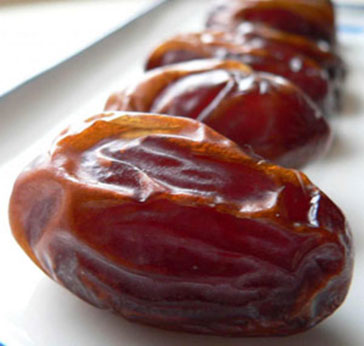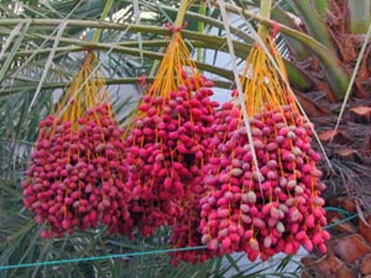Allah has granted humans a very rich plant kingdom, with around 422,000 species. In the midst of the astounding diversity of plants Kingdom, date palm stands out as a symbol of Islam and Muslims.
The first episode of this article discusses the significance and basics of date palm. This second episode lists its usage, benefits, and production.
Many Uses & Benefits
The date palm has a range of uses. High-energy date fruits have been placed high on the diets of the health-conscious. Though the fruit still has untapped potential in the food industry, it also lends itself to countless other uses.
Handicrafts, such as ropes and mats can be woven from the branches of the tree, while the bark is very useful as a building material.
In early descriptions of the Prophet Muhammad’s (SAW) mosque in Madinah, historians state that the leaves of the date palm were used as a roof covering.

Even the date stone is used as cattle feed, once it has been soaked and powdered. The juice from the date palm is an ingredient in baking and cooking.
Placed in the mouths of newborn babies, eaten at wedding celebrations and at the beginning and end of each day of fasting in Ramadan – dates are said to have great medicinal value. A medical study cited in the British Medical Journal (Haouari et al.) found that placing a sugary substance in the mouth of a baby reduces pain sensation and heart rate.
The sunnah (Prophetic tradition) of putting chewed dates or honey into the mouths of newborn babies at the name-giving ceremony on the 7th day after the child’s birth, therefore, carries great virtue and benefit.
According to a study by Al-Shahib and Marshall, in many ways, “dates may be considered as an almost ideal food, providing a wide range of essential nutrients and potential health benefits.”
The sugar content of ripe dates is about 80%; the remainder consists of protein, fat and mineral products including copper, sulfur, iron, magnesium and fluoric acid. Dates are high in fiber and an excellent source of potassium.
Growing Production
World production of dates has almost tripled, while export has increased by 1.71% in the last 40 years. This indicates an increase in the demand for this nutritious fruit.
Dates are also reputed to be useful in treating respiratory disorders, as well as a salve and a heart stimulant. It is also believed to be of benefit to pregnant women. In Surat Maryam, Allah provided Maryam (peace be upon her), the mother of Prophet ‘Eesa (peace be upon him), with dates when she was experiencing discomfort and pain during the final stages of her pregnancy.

In an article discussing the benefits of dates, Omar-Muhammad (2003) states that studies have shown that “dates contain certain stimulants which strengthen the muscles of the uterus in the last few months of pregnancy.”
This would then assist in the dilation of the uterus at the time of delivery. Dates are also recommended for women in the post-partum period and lactating due to its value as a nutritious, high-energy food.
The value of the date palm is still being understood. As an old Arab saying goes: The uses of the date palm are as many as the number of days in the year. The date palm is one of the many bounties that have been placed on this earth for us to benefit from. Next time we will look at az-Zaytoon, the olive, also discussed in the book, Plants of the Qur’an.
References:
- Agronomy and Range Science Management Department. The crop of the day: The Date, Phoenix dactylifera.
- http://agronomy.ucdavis.edu/gepts/ pb143/CROP/Date/Date.htm
- Al-Shahib, W and Marshall, RJ, 1993. The fruit of the date palm: it’s possible use as the best food for the future? International Journal of Food and Science Nutrition, 54(4): 247-259.
- Campbell, FA, no date. GEF steps in as 1000 date varieties in danger.
- http://www.gefweb.org/Whats_New /Archives/GEF_Steps_in.pdf
- Farooqi, I, 1997. Plants of the Qur’an. Sidrah Publishers: India.
- Haouari, N, Wood, C, Griffiths, G and Levene, M, 1995. The analgesic effect of sucrose in full-term infants: a randomized controlled trial. British Medical Journal 310:1498-1500. (http://www.bmj.com)
- Haykal, MI, 1990. The life of Muhammad. Crescent Publishing Company: India.
- Kasapis, S, no date. Dates: A fruit of promise for the food industry. http://www.nizwa.net/agr/dates/ datefruit/datefruit.html
- Nasr, SH, 1976. Islamic Science: An illustrated guide. World of Islam Festival Publishing Company Ltd.: England.
- Omar-Muhammad, R, 2003. Dates: The crown of sweets. The Muslim Woman, 4(7): 26.
- Relief of Pain: A Medical Discovery. Islamic Voice, 15-04: 172.
- http://www.islamicvoice.com/april.2001/quran.htm
This article is from our archive, originally published on an earlier date, and now republished for its importance.
